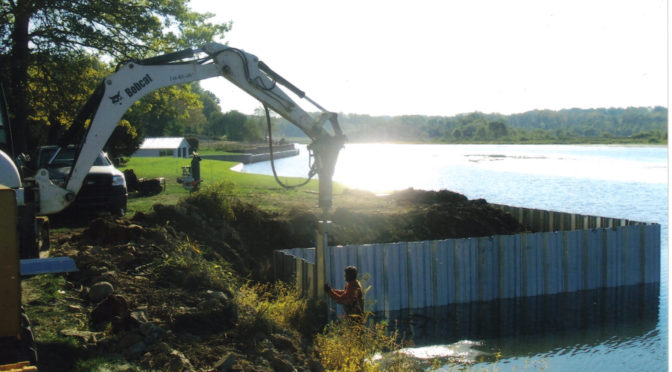We love getting on the water to fish, enjoy our boats, and maybe take a dive. But we often forget some of the most important parts of our waterfront experience. That is, how do we actually reach the water itself? Before we even start to think about our docks, we’ve got to take a look at the shoreline.
About Seawall Construction
Managing your shoreline isn’t all that glamorous, but it’s a necessary part of your overall waterfront experience. If you don’t have a solid shoreline in place, the rest of your property will start to suffer. To have your waterfront looking great for years to come, you often need a seawall to protect your land from erosion.
Seawalls are essentially retaining walls. When built properly, they work to keep your land steady, so your property doesn’t start to slide into the water. But they serve more than one purpose. Just as they keep your land out of the water, they also keep the water off of your land by limiting flooding. They also work to give you a reliable water depth, which we all need for boating. Lastly, seawalls give waterfront property a more finished look. They can be both practical and attractive.
The Different Seawall Types
Seawall construction can utilize a variety of different materials, including concrete or vinyl, but we tend to focus on two other seawall building options. For a true long-term solution, we’re advocates of steel sheet piling seawalls. If you need a permeable barrier, then we go with a rip rap seawall. Both have their benefits.
Steel sheet piling seawalls are great for shorelines that need extra stability. Because they’re so durable, they also work to create additional space for your waterfront. We often see steel sheet piling seawalls at marinas, commercial sites, and larger public areas and parks. It’s easy to turn the land behind the seawall into a picnic area or grassy spot to enjoy looking out on the water. These structures are more expensive, but they can also give you a better all-around value—even for private property. Plus, they tend to last longer than rip rap barriers.
That isn’t to say that a rip rap seawall is a bad choice. They just serve a different purpose. Rip rap is basically a rocky barrier that’s added in to reinforce a waterfront. Unlike a permanent seawall, these structures allow some water to reach the shoreline. It offers more gradual variations with the shoreline depth, so it’s the better option for local wildlife. They also have the benefit of creating a more natural look along the water.
Protecting Your Shoreline
Choosing the right seawall for your shoreline depends on the slope to the water, the activity on your waterfront, and the area’s natural elements. For example, a rip rap seawall might work just fine for a gentle slope, especially if the soil has a lot of clay and there aren’t strong currents. A steep slope, on the other hand, would probably require a steel sheet piling seawall. Shorelines with a lot of sand can also benefit from these stronger structures. The same goes for areas that have a lot of waterfront activity. Busy shorelines might need a permanent barrier for safety reasons.
Of course, the best way to determine what seawall type you should go with comes down to a consultation. Talking with your local waterfront experts will give you a better idea of what your site needs. And if your shoreline is starting to slide, or your current seawall construction is failing, the sooner you can talk with a crew, the better. You might be able to get by with a seawall repair instead of a total replacement.
If you’d like our team at Deaton’s Waterfront Services to weigh in on your options, feel free to send us a message. We have experience with both commercial seawalls and residential structures. Let us know if we can schedule a video call or in-person visit to discuss your needs. For any and all seawall questions, we’re here to help!

